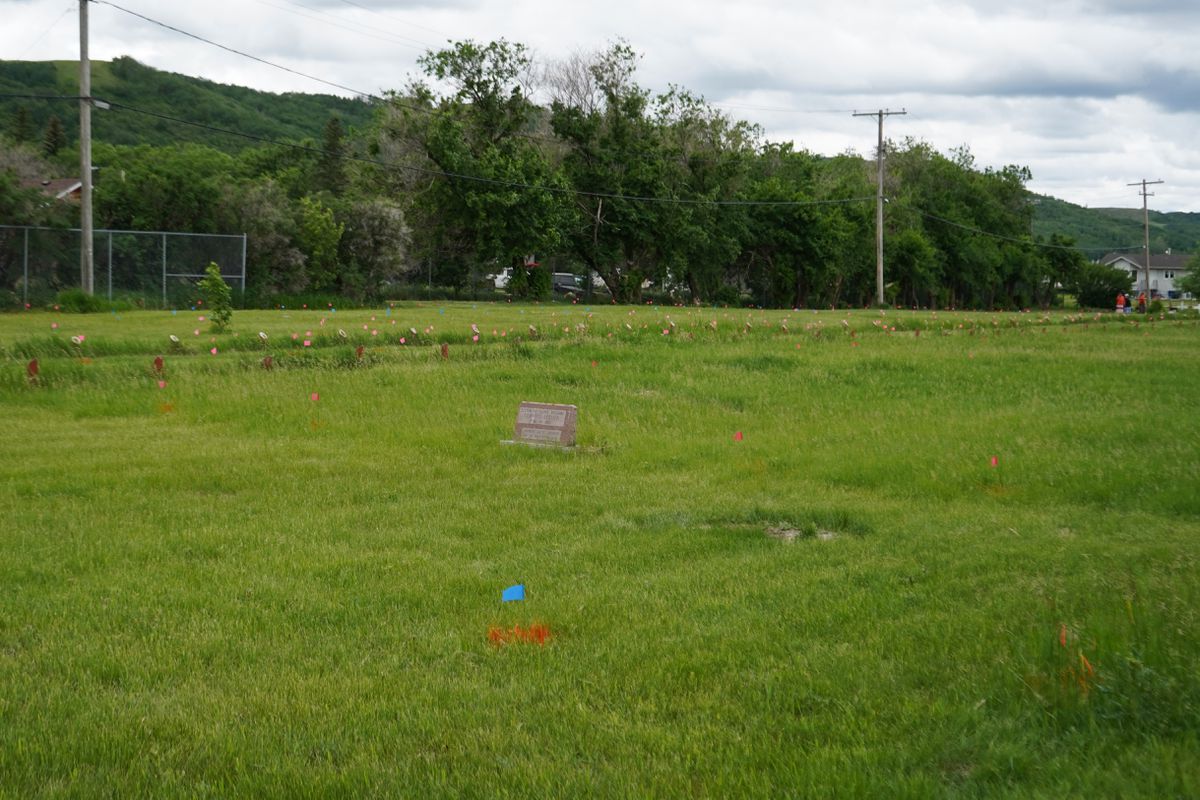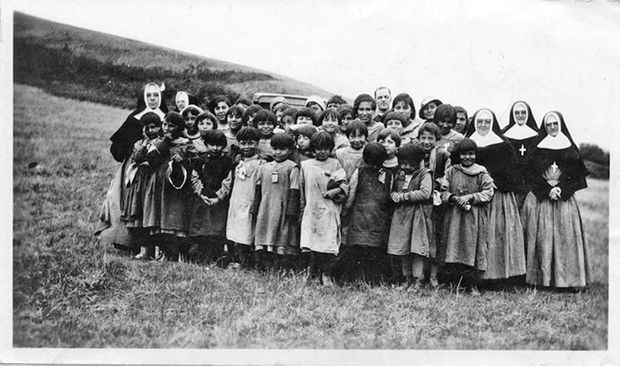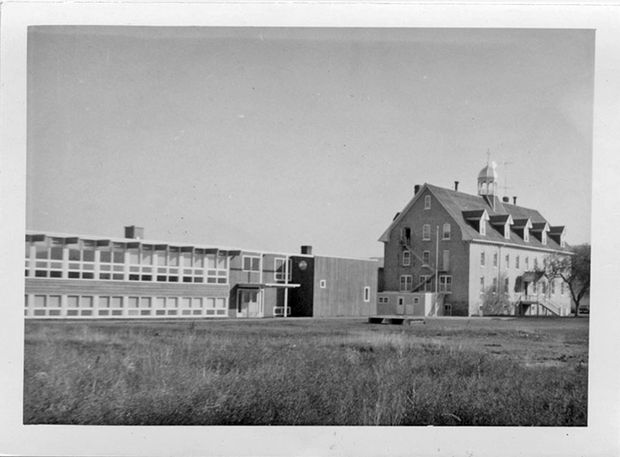
Coloured flags mark what officials say are 751 unmarked graves at the site of the former Marieval Indian Residential School in Saskatchewan on June 18, 2021. COURTESY OF COWESSESS FIRST NATION
Cowessess First Nation will explain the ‘horrific’ discovery on the grounds of the former Marieval Indian Residential School on Thursday.
On a grass-covered plot of land on the Cowessess First Nation, neat lines of coloured flags stand over what officials say are 751 unmarked graves, discovered in the Roman Catholic cemetery at the site of the former Marieval Indian Residential School.
Chief Cadmus Delorme said the gravesite is locally believed to include the bodies of both children and adults, possibly including people from outside the community who attended church there.
“Over the past years, the oral stories of our elders, of our survivors and friends of our survivors, have told the stories that we knew these burials were here,” said the chief, who leads the First Nation about 160 kilometres east of Regina, speaking to reporters from around the world during a press conference on Zoom Thursday morning.
The announcement was made less than a month after leadership of the Tk’emlúps te Secwépemc Nation in southern B.C. said 215 unmarked graves of children had been located at the former Kamloops Indian Residential School.
The revelation of these unmarked gravesites is part of a stark and painful history that is increasingly being recognized and acknowledged around the country. The discoveries have caused an outpouring of grief and calls for action, and the federal government and some provinces have pledged millions to First Nations to investigate and locate unmarked graves in their communities.
Mr. Delorme wore a red dress pin on his lapel signifying missing and murdered Indigenous women. Underneath his blazer was an orange shirt, representing the legacy of Canada’s residential-school system.
“In 1960, there may have been marks on these graves,” said Mr. Delorme, about the 751 unmarked graves found in Cowessess. “The Catholic Church representatives removed these headstones, and today they are unmarked graves.”
It’s not clear why any grave markers that once existed were removed. But the chief noted that removing headstones is a crime in Canada, and added, “We are treating this like a crime scene at the moment.”
He repeatedly stressed that the remains are “not a mass grave site,” but unmarked individual burial sites.
In a letter to the chief and community residents, Archbishop of Regina Don Bolen said the revelation, “brings us face to face with the brutal legacy of the Indian Residential School system, a product of a colonialist history, which has left so much suffering and intergenerational trauma.”
“The operation of the Marieval Residential School at Cowessess left many people deeply wounded by various kinds of abuse,” Archbishop Bolen wrote.
He reiterated an apology he said he made in the community two years ago, “for the failures and sins of church leaders and staff in the past towards the people of Cowessess.”
“I know that apologies seem a very small step as the weight of past suffering comes into greater light, but I extend that apology again, and pledge to do what we can to turn that apology into meaningful concrete acts,” he wrote. He said that includes helping the community access information about those buried in the unmarked graves, “and to stand by you in whatever way you request.”
His letter makes reference to being told by the community about “how one priest who served in the region in the 1960′s destroyed headstones in a way which was reprehensible,” but there were no other details.
In a statement, Saskatchewan RCMP said police would continue to work in partnership with the Cowessess First Nation and the Federation of Sovereign Indigenous Nations (FSIN) “as next steps are considered and they determine if or how they wish the RCMP to be involved.” The FSIN represents 74 First Nations in the province.
“Our actions must be respectful of the immense grief the people of Cowessess First Nation continue to suffer,” the statement read. “We know we have enforced racist and discriminatory legislation and policies.”
Saskatchewan Commanding Officer Rhonda Blackmore said the announcement is “a sombre reminder of the dark legacy of Indian Residential Schools in our province.”
“Respectfully, this is the time for the Saskatchewan RCMP to offer support wherever we can and share in the sadness of our Indigenous communities,” she was quoted as saying.
Mr. Delorme said work began at the site in Cowessess in early June, with technicians from Saskatchewan Polytechnic using ground-penetrating radar, or GPR, to search a 44,000-square-metre plot that was the Roman Catholic gravesite, which is located alongside what later became a community cemetery.

Young girls from the Indian school of Marieval, Saskatchewan and a group of Sisters of Saint Joseph and Father Placide Châtelain in 1934. SOCIÉTÉ HISTORIQUE DE SAINT-BONIFACE / OBLATS DE MARIE-IMMACULEE DU MANITOBA
He said the search is only the first phase of work in the community, and that other sites – including areas where unbaptized babies are said to have been buried – will come later. He said the technicians performing the work told him there is a margin of error of 10-to-15 per cent.
Larry Rosia, president and CEO of Saskatchewan Polytechnic, said a team of experts, which included at least three faculty members, employed drones equipped with imaging sensors to map out the area from above, then used GPR to identify the individual graves. Mr. Rosia said the project was funded by the Natural Sciences and Engineering Research Council of Canada. It came about after a partnership with Cowessess that started in 2018 as a way to map the territory with digital tools so first responders didn’t have to rely on paper maps when rushing to emergencies.
Prime Minister Justin Trudeau said the findings at the Marieval and Kamloops schools are “part of a larger tragedy,” and “a shameful reminder of the systemic racism, discrimination and injustice that Indigenous Peoples have faced – and continue to face – in this country.”
“I recognize these findings only deepen the pain that families, survivors and all Indigenous Peoples and communities are already feeling, and that they reaffirm a truth that they have long known,” he said in a statement. “The hurt and the trauma that you feel is Canada’s responsibility to bear.”
The federal government once funded more than 130 residential schools for Indigenous children around the country, about 60 per cent of which were operated by the Catholic Church. The Truth and Reconciliation Commission (TRC) has described the schools – which operated until the 1990s and sought to strip Indigenous children of their language, traditions and identity – as “cultural genocide.”
Mr. Trudeau said Ottawa will provide Indigenous communities across the country with funding and resources as needed, and the government has made $27-million available on an “urgent basis” for further investigation of former residential school sites.

In 1898, surrounded by five reservations, Marieval Residential School was established near Crooked Lake and dedicated to the Holy Heart of Mary. SOCIÉTÉ HISTORIQUE DE SAINT-BONIFACE / OBLATS DE MARIE-IMMACULEE DU MANITOBA
The funding had been set aside in the 2019 federal budget for the creation of a registry of student deaths at residential schools, and to help Indigenous communities hire archeological search companies to locate unmarked burial sites and commemorate children who died.
Cowessess Elder Florence Sparvier began the press conference Thursday with a Cree prayer, and later shared some of her own experience at the Marieval residential school. She described how parents would be jailed if they didn’t give up their children to the school, where students endured mistreatment, had their cultural practices and beliefs denigrated, and had lessons “pounded into us.”
“They were very condemning about our people. They told us our people, our parents or grandparents didn’t have a way to be spiritual, because we were all heathens,” said Ms. Sparvier, who said her mother and grandmother attended the school before her.
“They were putting us down as a people, so we learned how to not like who we were. And that has gone on and on, and it’s still going on…,” said Ms. Sparvier, who is 80. “When we became assimilated, they made us think different, and feel different. So a lot of the pain that we see in our people right now comes from there.”
“They made us believe we didn’t have souls,” she said.
A 266-page report entitled “Missing Children and Unmarked Burials,” which was part of The Truth and Reconciliation Commission’s findings in 2015, said that “many, if not most,” of the children who died in residential schools were likely to have been buried in “unmarked and untended graves.”
The cause of death was unknown in nearly half the identified cases. The causes recorded in other cases included deaths from illness such as tuberculosis, deaths from accidents and fire, and children who died after running away.
About 150,000 children are estimated to have attended residential schools in Canada, and the National Centre for Truth and Reconciliation (NCTR) has so far confirmed the identities of 4,117 children who died at or after attending the schools. Former senator Murray Sinclair, who chaired the TRC, has said the number of children who died at the schools could be between 15,000 and 25,000.
Speaking at Thursday’s press conference, FSIN Chief Bobby Cameron said the search for unmarked graves will not stop.
“We will do a search of every Indian Residential School site and we won’t stop there. We will also search all of the sanatoriums, Indian hospitals and all the sites where people were taken and abused, tortured, neglected and murdered,” he said. “We will tell the stories of our children, of our people who died. Who were killed by the state, by the churches, and we won’t stop until we locate all of them. The world is watching as we unearth the findings of genocide.”

Young girls from the residential school in Marieval, Saskatchewan, sitting in the sewing room in 1926. SOCIÉTÉ HISTORIQUE DE SAINT-BONIFACE / OBLATS DE MARIE-IMMACULEE DU MANITOBA
In a joint statement with the Manitoba Keewatinowi Okimakanak, which represents 26 northern First Nations, Southern Chiefs’ Organization Grand Chief Jerry Daniels said the findings “further reveal this country’s history of committing genocide against First Nations and Indigenous Peoples.”
“We knew there were going to be more discoveries such as this, however nothing truly prepares you emotionally, especially when we consider the sheer volume in this particular case,” his statement read.
He said all Canadians need to “fully acknowledge this country’s history of sexual, physical, emotional and lethal abuses that our people were subjected to, just for being First Nation.”
The Native Women’s Association of Canada said it was writing to the federal Attorney-General to ask that all former residential-school sites immediately be declared crime scenes, and that investigations be conducted to determine how each child buried at the sites died and who is responsible for their deaths.
The association is also asking that charges be laid against people who are found to have been perpetrators of crimes, including members of religious orders that ran the schools and governments and churches “that we know to be complicit.”
Stephanie Scott, the executive director of the NCTR, said undocumented gravesites were a reality of the residential-school legacy that Canadians have overlooked for too long.
“This horrific truth can no longer be ignored,” she said. “The least governments and churches must do now is to provide access to the necessary records to identify the locations of all the children and allow communities to honour them with the traditional ceremonies and protocols they were denied.”
She said the NCTR and Indigenous communities must have complete access to any outstanding records, and that there must be additional supports for survivors and their families while those lost to the residential-school system are mourned and honoured.
Speaking on Thursday, Chief Delorme said dealing with the unmarked graves in his community is going to take years. He said he’s already been in contact with government and church officials, and is optimistic they will be able to obtain records and be able put names to each of the unmarked graves. He said the community will then preserve the site, and put a monument there.
He acknowledged that the process will be painful, but said having the truth heard and accepted will ultimately bring healing. He implored people to move past ignorance and “accidental racism,” and to stand with Indigenous communities.
“We are not asking for pity, we are asking for understanding. We need time to heal, and this country must stand by us,” he said.
“There’s going to be many more stories in the future,” he added. “And this is Cowessess First Nations’ moment of our truth.”
JANA G. PRUDEN, KRISTY KIRKUP,
MIKE HAGER AND CARRIE TAIT
The Globe and Mail, June 23, 2021

